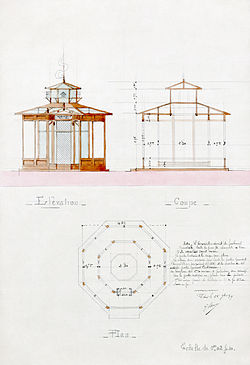20th century to modern day
In 1902, a flying cage was completed in the setting of the National Zoological Park of the Smithsonian Institution. A new Great Flying Cage was built in 1964. [6]
The Saint Louis Zoo is home to the 1904 World's Fair Flight Cage. It is one of only two permanent structures built for the World's Fair which still remain (the other is the Saint Louis Art Museum's Cass Gilbert building). In 1904, it was the largest bird cage ever built. It remains one of the world's largest free-flight aviaries. The 69 m (228 ft) long, 26 m (84 ft) wide, and 15 m (50 ft) high cage was built by the Smithsonian Institution specifically for the St. Louis World's Fair. Local pride in the giant cage motivated St. Louis to finally establish a zoo in 1910.
In 1937, the San Diego Zoo's aviary designed by architect Louis John Gill opened; it was then the largest in the world. The mammoth steel structure, 55 m (180 ft) long, 18 m (60 ft) wide and more than 30 m (100 ft) high, funded by the Works Progress Administration at a cost of $50,000, had no beams, cross or guy-wires to impede the flight of the birds. [7] [8]
With the Antwerp cage system (1948), birds are only separate from public with a light system used indoor the Bird Building at Antwerp Zoo. [9]
At the Frankfurt Zoo, the bird house was built in 1969. Its Bird Halls presented birds for the first time in large glassed miniature habitats. In diving exhibits, darters and kingfishers could be seen hunting under water, and in the free-flight hall visitors still walk amongst tropical birds in dense vegetation. [10] In 1963, the same principle was used outdoors to construct the Bird Thicket, ten aviaries surrounded by dense bushes and designed in various habitat settings, which visitors can enter through wire netted doors and curtains of cords. [10]
The Snowdon Aviary in London Zoo was designed by Antony Armstrong-Jones, 1st Earl of Snowdon, Cedric Price and Frank Newby, and built in 1962–1964. [4]
The Bronx Zoo's World of Birds, a two-story bird house completed in 1972, is a huge, landscaped, indoor free-flight exhibit. The one-way flow pattern in the exhibit moves the visitors through twenty-five birds habitats, ranging from desert to tropical forest. Each setting recreates with impressive fidelity the microculture of the birds that fly merrily about within their diorama world, complete with living plants. Five of the aviaries are completely open: in two of the largest the uncaged public walks through the habitat with birds freely overhead. [11]
The Henry Doorly Zoo's Simmons Aviary opened in 1983 and is one of the world's largest free-flight aviaries. About 500 birds from all parts of the world occupy the area of the aviary. In this 16,000-square-metre (4-acre) exhibit, visitors see flamingos, ducks, swans, storks, cranes, spoonbills, ibis and egrets. The Aviary is 240 m (800 ft) long and rises to 23 m (75 ft) at the center. The structure of two-inch nylon mesh is supported by a system of cables and poles. The use of nylon instead of wire is a unique concept. [12]
Birds of Eden bird sanctuary, located in the Western Cape of South Africa, is possibly the largest free flight aviary in the world. The aviary opened in 2005 and covers an area of 21,761 m2 (234,230 sq ft) with a total volume of 375,372 m3 (13,256,100 cu ft). It is home to around 3,000 individual birds from 200 species.







